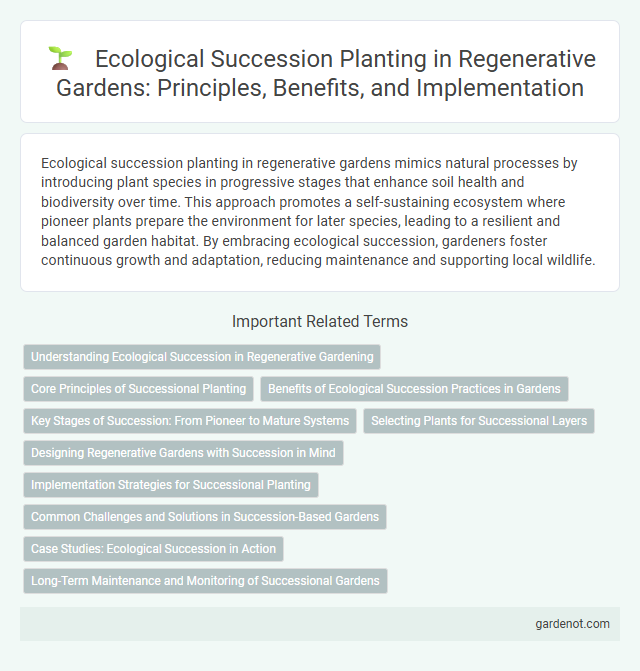Ecological succession planting in regenerative gardens mimics natural processes by introducing plant species in progressive stages that enhance soil health and biodiversity over time. This approach promotes a self-sustaining ecosystem where pioneer plants prepare the environment for later species, leading to a resilient and balanced garden habitat. By embracing ecological succession, gardeners foster continuous growth and adaptation, reducing maintenance and supporting local wildlife.
Understanding Ecological Succession in Regenerative Gardening
Ecological succession in regenerative gardening refers to the natural progression of plant communities that restore soil health and biodiversity over time. By mimicking these successional stages, gardeners can enhance nutrient cycling, improve habitat complexity, and promote resilient ecosystems. This approach encourages planting pioneer species that enrich the soil, followed by intermediate and climax species to create a self-sustaining garden.
Core Principles of Successional Planting
Ecological succession planting in regenerative gardens emphasizes biodiversity by integrating pioneer species that improve soil health and facilitate the establishment of later, more complex plants. This core principle supports natural progression and resilience, mimicking native ecosystems to optimize nutrient cycling and habitat creation. Strategic layering of plants according to their successional stage enhances productivity and sustainability without synthetic inputs.
Benefits of Ecological Succession Practices in Gardens
Ecological succession planting in regenerative gardens enhances soil health by promoting nutrient cycling and increasing microbial diversity. This practice supports biodiversity by creating layered habitats that attract pollinators and beneficial insects. Gradually establishing stable plant communities improves ecosystem resilience, reducing the need for synthetic inputs and lowering maintenance requirements.
Key Stages of Succession: From Pioneer to Mature Systems
Ecological succession in regenerative gardening progresses through distinct stages, beginning with pioneer species like grasses and legumes that stabilize soil and enrich nutrients. Intermediate stages feature shrubs and fast-growing trees establishing complex habitats and increasing biodiversity. Mature systems consist of diverse, multi-layered plant communities, creating resilient ecosystems with improved water retention and carbon sequestration.
Selecting Plants for Successional Layers
Selecting plants for successional layers in a regenerative garden involves choosing species that support natural ecological progression, starting with pioneer plants that improve soil fertility and moisture retention. Mid-successional shrubs and perennial herbs provide habitat complexity and nutrient cycling, while climax species such as native trees ensure long-term stability and biodiversity. Integrating diverse plants adapted to local climate and soil conditions accelerates succession and enhances ecosystem resilience.
Designing Regenerative Gardens with Succession in Mind
Designing regenerative gardens with ecological succession in mind involves selecting plant species that naturally progress through various growth stages, enhancing soil health and biodiversity over time. Incorporating pioneer plants followed by intermediate and climax species creates resilient ecosystems that support sustainable nutrient cycling and habitat diversity. This approach optimizes long-term garden productivity and ecosystem stability by mimicking natural succession processes.
Implementation Strategies for Successional Planting
Implementing successional planting in regenerative gardens involves selecting native pioneer species that improve soil health and create microenvironments for later-stage plants. Strategic layering with nitrogen-fixing plants enhances nutrient cycling and supports biodiversity throughout each growth stage. Continuous monitoring and adaptive management ensure optimal plant establishment and resilience against environmental stresses.
Common Challenges and Solutions in Succession-Based Gardens
Ecological succession planting in regenerative gardens often faces challenges such as soil nutrient depletion, invasive species competition, and unpredictable climate conditions. Implementing diverse plant species that support each other's growth, utilizing nitrogen-fixing plants, and monitoring soil health regularly can mitigate these issues. Employing adaptive management strategies and establishing native plant communities enhance resilience and promote sustainable garden ecosystems.
Case Studies: Ecological Succession in Action
Ecological succession planting demonstrates significant biodiversity restoration through staged planting techniques, as evidenced by the Stanford University-led project revitalizing coastal scrublands over a decade. Case studies reveal that pioneer species like lupines and willow rapidly improve soil health, allowing secondary species to establish, which enhances ecosystem resilience and carbon sequestration. Field data from the Eden Project in Cornwall confirms these methods increase native flora density by 40%, proving ecological succession's pivotal role in regenerative garden design.
Long-Term Maintenance and Monitoring of Successional Gardens
Long-term maintenance and monitoring of successional gardens prioritize adaptive management to support ecological succession stages, ensuring plant community resilience and biodiversity enhancement. Regular assessment of soil health, species composition, and invasive species control is essential to sustain ecosystem functions and promote habitat complexity. Implementing data-driven interventions based on successional dynamics fosters stable, self-sustaining regenerative garden ecosystems over decades.
Ecological succession planting Infographic

 gardenot.com
gardenot.com